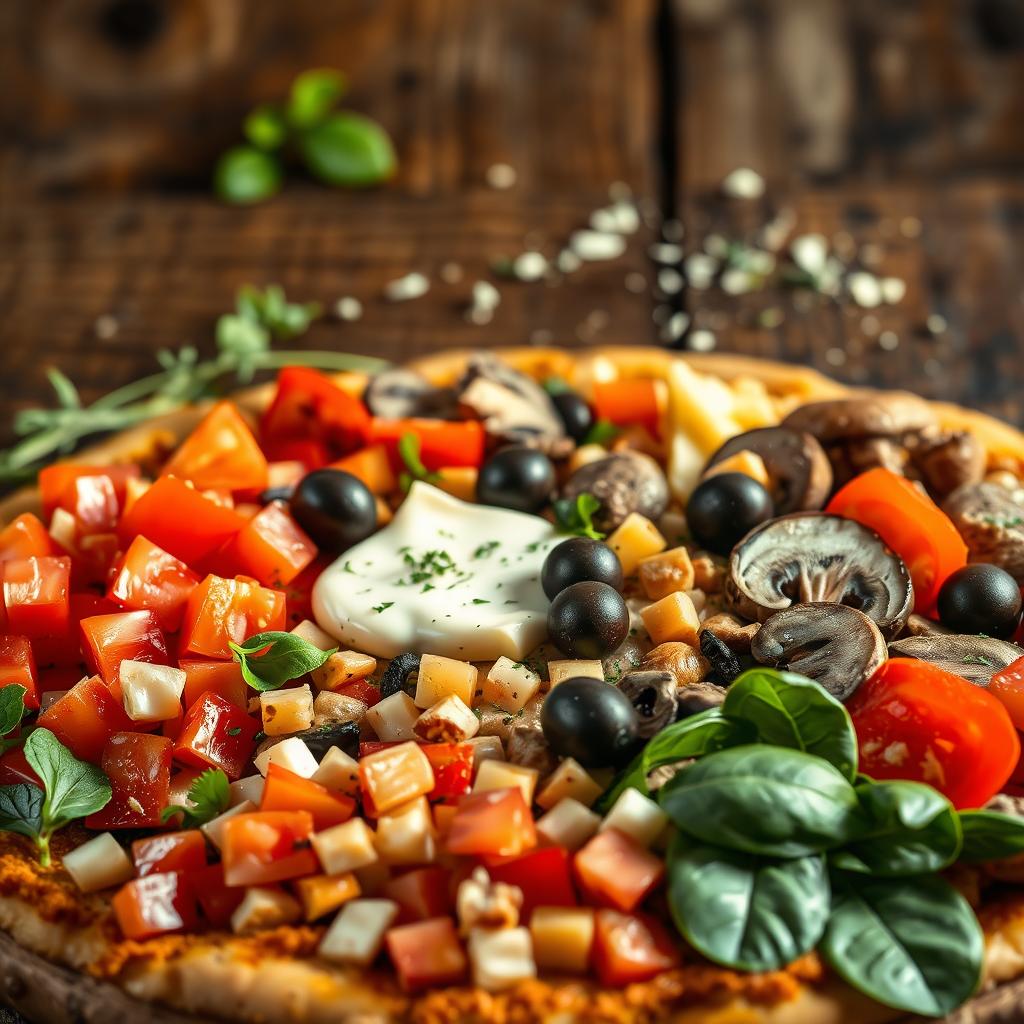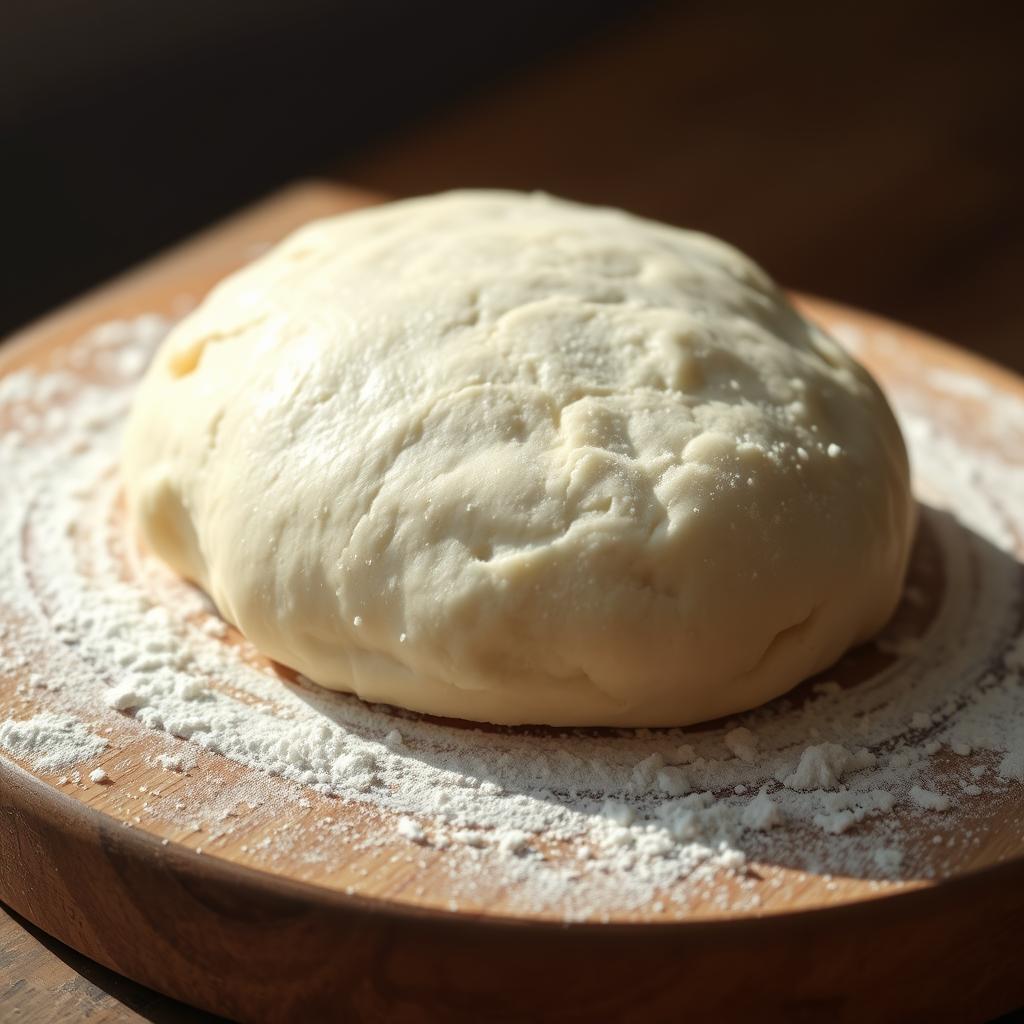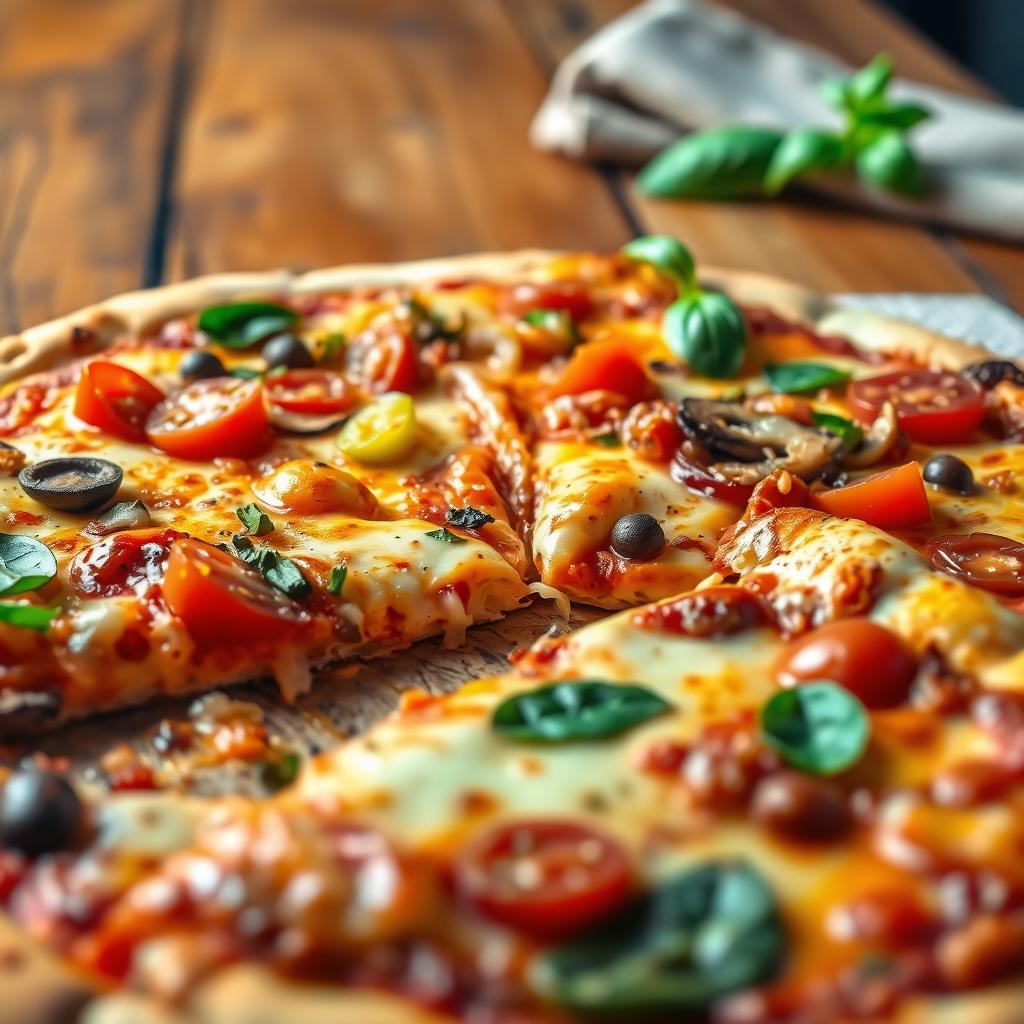Vegan pizza recipes can deliver bold flavor with simple ingredients and pro-tested methods you can use tonight.
Can a home oven, a quick-rise dough, and a simple cashew cream turn your weeknight into a pizzeria-level meal?
You’ll learn hands-on steps for dough that activates with water at 110°F, sauce options from tomato to white bean, and how to make vegan cheese melt and brown.
Recipes from Love & Lemons, The Banana Diaries, and Vegan Huggs show oven temps from 450°F to 500°F, baking 10–15 minutes, parchment-slide techniques, and brushing crusts with olive oil and herbs.
By the end, you’ll have a repeatable workflow for dough, sauce, toppings like sun-dried tomato and jalapeño, and a finishing drizzle of cashew cream and fresh basil.
Key Takeaways
- Learn a step-by-step dough method using water at 110°F and quick-rise yeast.
- Compare sauces: cashew cream, tomato, pesto, and white bean spreads.
- Follow baking options: tray, cast iron, grill, and parchment slide at high heat.
- Choose vegan mozzarella brands that brown and stretch well.
- Use simple ingredients and timing to make great pies in minutes for gatherings or weeknights.
Start Here: vegan pizza recipes for flavorful, foolproof pies at home
Vegan pizza recipes begin with a short roadmap: mix dough, let it rest, shape by hand, spread sauce, add cheese, and bake until the crust is golden.
Plan your time by measuring ingredients up front and activating yeast while you prep toppings. Use a bowl large enough for the dough to double and keep a little flour to prevent sticking.
Choose between a 475°F bake for quicker melt and chew or a 500°F hot-bake for a crisp, restaurant-style crust. The Banana Diaries method favors 475°F for a medium crust that finishes in 10–12 minutes. Vegan Huggs shows a 500°F, parchment-to-rack approach that finishes in 10–15 minutes.
- Lightly brush the rim with olive and herbs for a golden edge.
- Pick a sauce: classic tomato or a rich cashew/white-bean spread.
- Top sparingly with high-moisture vegetables or pre-cook them to avoid sogginess.
| Method | Oven Temp | Bake Time | Shape |
|---|---|---|---|
| Medium-crust (hand-shaped) | 475°F | 10–12 minutes | By hand on parchment |
| Hot-bake (restaurant-style) | 500°F | 10–15 minutes | Slide on parchment to rack |
| Quick weeknight | 475–500°F | 10–15 minutes | Hand-shaped, lightly floured surface |
Keep your first bake simple. Finish with fresh basil after the pie comes out of the oven and build on this base to make the best vegan variations in minutes.
From Bowl to Crust: Mastering Vegan Pizza Dough
Start simply: gather your flour, warm water, quick-rise yeast, sea salt, a touch of olive oil, and a pinch of sugar. Measure in a bowl so you control hydration and texture.
Simple ingredients that deliver
Use 00 or all-purpose flour for a tender crumb. Bloom the yeast in water at 110°F; too hot will kill it, too cool will slow it.
- Measure flour, water, yeast, salt, olive oil, and a pinch of sugar for steady fermentation.
- Keep salt modest for flavor and gluten strength; use sea salt.
Activate your yeast and proof for texture
Knead 7–9 minutes by hand or mixer until the dough is smooth and slightly tacky. Let it rise in a warm spot until it doubles.
“If the dough resists stretching, rest it 5–10 minutes to relax the gluten.”
Shape on a floured surface or parchment
Shape with your fingertips on a lightly floured surface or on parchment. Avoid a rolling pin so you preserve the gas bubbles that make a light crust.
- Divide dough to match oven size; smaller rounds bake more evenly.
- Optional: add a touch of sugar or garlic powder for extra depth (per Vegan Huggs).
Sauce, “Cheese,” and Beyond: Building Bold Plant-Based Flavor
Pick a sauce that sets the tone—acidic tomato for a classic pie, or a silkier cashew cream for richness and depth.
Tomato sauce is your go-to when you want bright acidity and a clean canvas for herbs, olives, and mushrooms. Spread it thin to avoid a soggy center and add a small sprinkle of salt to balance sweetness.
Tomato or cashew—when to choose which
Choose cashew cream when you want a creamy mouthfeel without dairy. Use a thin layer under vegetables and drizzle more after baking, as Love & Lemons recommends.
Melty vegan cheese and mozzarella options
For melt and browning, reach for Violife shreds or Miyoko’s mozzarella. Both perform well in high heat. If you prefer a homemade vegan option, blend a bean-based or cashew-based cheese to control salt and texture.
Pesto and lemon-dill white bean spreads
Try pesto as a base with cherry tomato and olive slices for color and aroma. Or make a lemon-dill white bean spread (cannellini, garlic, lemon, dill, olive oil) for protein and creaminess.
- Layer sauces thin to protect the dough and ensure an even bake.
- Match sauce to toppings: brighter tomato for hearty veg, creamy bases for delicate herbs.
- Finish with fresh basil after the bake for a fragrant lift.
Vegan Pizza Toppings That Shine

Top your pie with a mix of textures and flavors so every bite feels balanced and bright.
Classic picks that always work
Use sun-dried tomato, fresh basil, mushrooms, olives, sliced garlic, and jalapeño for reliable flavor. Cut vegetables uniformly so they roast evenly and finish in the same bake window.
Seasonal upgrades and smart swaps
Try broccoli florets, corn kernels, roasted peppers, figs, or lemon-dill white beans for protein and sweetness. Pre-roast dense veg in olive oil and a pinch of salt to jump-start caramelization.
- Build a balanced grid: sweet (corn), salty (olives), tangy (sun-dried tomato), heat (jalapeño), herbaceous (fresh basil).
- Blot oil-packed sun-dried tomatoes and olives so they don’t grease the surface.
- Spoon white beans in small dollops for creamy, protein-packed bites that won’t collapse the center.
- Place heavy items near the rim and avoid piling toppings high in the pan or on a thin crust.
Pro tip: Add delicate herbs and fresh basil after baking and reserve a final drizzle of olive oil for shine. These small moves make the best vegan pizza tastes pop.
Bake, Grill, or Cast Iron: Getting the Perfect Crust Every Time
Whether you bake in an oven, finish on a grill, or sear in cast iron, the approach is the same: use fast, even heat so the crust sets and toppings cook in sync.
Preheat oven to 475–500°F and let the stone or pan warm for at least 30 minutes. Aim for a 10–15 minutes bake depending on rack position and how many toppings you add.
Quick method notes
- Use a pizza tray, baking sheet, or cast iron skillet; cast iron gives great browning on the bottom.
- Build your pie on parchment or a floured surface so transfers go smoothly.
- Brush the rim with a little olive oil for color and a tender bite.
- For the grill: oil the dough, grill 2–3 minutes per side, then top, cover, and finish until the mozzarella melts.
“Rotate halfway if your oven has hot spots; watch for golden edges as your doneness cue.”
| Method | Temp | Bake Time | Notes |
|---|---|---|---|
| Home oven (stone/tray) | 475–500°F | 10–15 minutes | Preheat stone/pan 30 min; slide on parchment |
| Cast iron | 475°F | 10–12 minutes | Heat pan first for crisp bottom |
| Gas/charcoal grill | ~500°F | Grill 2–3 min per side, finish 5–8 min | Oil dough, flip, then top and cover |
Timing, Tools, and Pro Tips for Best Results

Nail warm-water proofing, preheat your pan, and the rest of the bake falls into place.
Quick wins: use a kitchen thermometer to keep water at 110°F so the yeast activates reliably. Proof your dough in a warm spot and keep the bowl covered to stop a dry skin from forming.
Brush olive oil on the edges before baking to encourage color and a tender chew. Preheat your pan or cast iron so the bottom gets an instant jump on heat and color.
Smart sequencing and small moves
- Layer sauce thin, then cheese, then vegetables; finish delicate herbs after the bake.
- Place heavier toppings toward the edges to protect the center from soggy spots.
- Keep a sheet of parchment ready for easy transfer and a crisp bottom.
- Give vegetables a light sprinkle of salt and pepper before they go on the pie.
- If short on minutes, divide the dough into smaller rounds—they bake faster and more evenly.
“Let the baked pie rest briefly so the crust sets and slices lift cleanly.”
Curated Resources to Make Vegan Pizza Recipes Easier
Follow these sources for clear photos, timing tips, and brand notes that help you choose a melt-friendly cheese and the right pan.
Love & Lemons offers a veggie-forward cashew cream base and topping combo (broccoli, corn, sun-dried tomatoes, jalapeño). Bake at 450°F for about 15 minutes and finish with a generous post-bake cashew drizzle and fresh basil.
Love & Lemons
- Focus: cashew cream, colorful toppings.
- Notes: 450°F bake, finish with red pepper flakes.
The Banana Diaries
Use this guide for detailed dough technique: 00 flour, quick-rise yeast with water at 110°F, olive oil, and sea salt. The post lists vegan cheese brands that melt well and a grill finish option.
Vegan Huggs
Follow the hot-bake parchment slide: 500°F, middle rack, 10–15 minutes. Brush edges with olive and herbs for a golden rim.
| Source | Method | Temp | Bake Time | Notes |
|---|---|---|---|---|
| Love & Lemons | Cashew cream + veggie toppers | 450°F | ~15 minutes | Finish with cashew drizzle, basil |
| The Banana Diaries | Detailed dough, grill option | 475°F (oven) / ~500°F (grill) | 10–12 minutes (oven) | Calls out Violife, Miyoko’s; 110°F water |
| Vegan Huggs | Parchment slide, hot-bake | 500°F | 10–15 minutes | Slide to middle rack; brush rim with olive |
How to use these links: consult photos for thickness, check pizza sauce quantities, and match oven or pan choices to your setup. Combine techniques—parchment slide, grill finish, and cashew cream—to build your best homemade vegan routine.
Key Techniques for Perfect Vegan Pizza Crust and Crumb
,
Small technical moves—warm water, hand shaping, and a hot surface—deliver the best crust and crumb.
Start with water at 110°F to wake your yeast, mix in flour and a cup-measured bowl, and give the dough patient proofing. Then preheat oven or iron so the bottom gets an instant jump.
Use the parchment slide method or a grill finish for char and quick melt. Bake 10–15 minutes and watch the edges for a golden cue to pull the pie.
Choose tomato sauce for tang or a creamy post-bake drizzle for richness, add a little vegan mozzarella if you want stretch, and finish with fresh basil.
Revisit the DoFollow resources above to refine timing and troubleshoot oven quirks. Now preheat, top, bake, and enjoy your next pizza night.




